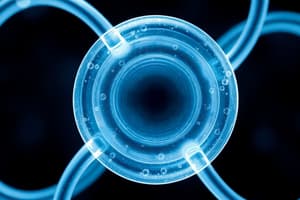Podcast
Questions and Answers
What defines the atomic number (Z) of an atom?
What defines the atomic number (Z) of an atom?
- The sum of protons and neutrons in the nucleus
- The number of protons in the nucleus (correct)
- The number of neutrons in the nucleus
- The total number of electrons surrounding the nucleus
Which of the following correctly describes isotopes?
Which of the following correctly describes isotopes?
- Atoms that have equal numbers of protons and neutrons
- Atoms with the same number of protons but different atomic numbers
- Atoms that have the same number of neutrons and different electrons
- Atoms of the same element that contain different numbers of neutrons (correct)
What is the formula for the polyatomic ion sulfate?
What is the formula for the polyatomic ion sulfate?
- SO4^2– (correct)
- SO4^–
- SO3^2–
- SO2^–
From which position in the Periodic Table can you predict the charge of the ion formed by elements in Group 3?
From which position in the Periodic Table can you predict the charge of the ion formed by elements in Group 3?
What is the relative atomic mass defined in terms of?
What is the relative atomic mass defined in terms of?
Which element from Group 4/14 can form multiple ions?
Which element from Group 4/14 can form multiple ions?
What distinguishes isotopes of an element?
What distinguishes isotopes of an element?
Given an atom with 6 protons, 8 neutrons, and 6 electrons, what is the mass number (A) for this atom?
Given an atom with 6 protons, 8 neutrons, and 6 electrons, what is the mass number (A) for this atom?
Which of the following defines relative isotopic mass?
Which of the following defines relative isotopic mass?
If an element in Period 3 is in Group 1, what charge would the ion typically have?
If an element in Period 3 is in Group 1, what charge would the ion typically have?
Which of the following is a characteristic of ionic compounds when forming from their constituent ions?
Which of the following is a characteristic of ionic compounds when forming from their constituent ions?
Which polyatomic ion correctly matches with its formula of PO4?
Which polyatomic ion correctly matches with its formula of PO4?
Flashcards are hidden until you start studying
Study Notes
Atomic Structure
- Atoms consist of protons, neutrons, and electrons; their quantities define the atom's structure.
- Atomic number (Z) indicates the number of protons in an atom.
- Mass number (A) is the total count of protons and neutrons in the nucleus.
Nuclear Symbols
- Constructing nuclear symbols requires knowing the numbers of protons, neutrons, and electrons.
- The nuclear symbol is represented as A/Z Element (e.g., ^12_6C for carbon-12).
Isotopes
- Isotopes are variations of an element that differ in neutron count and thus mass.
- While isotopes have the same chemical properties, they may exhibit different physical properties.
Atomic Mass Definitions
- Relative isotopic mass is based on a specific isotope compared to carbon-12.
- Relative atomic mass is a weighted average of all isotopes of an element, also referenced to carbon-12.
Ion Charge Prediction
- The charge on an ion can be predicted using the element's position in the Periodic Table, applicable to Main Group elements in Periods 1, 2, and 3.
Group 4/14 Elements
- Elements in Group 4/14, specifically tin (Sn) and lead (Pb), are known to form multiple ions.
Polyatomic Ions
- Polyatomic ions and their formulas include:
- Nitrate: NO3–
- Carbonate: CO32–
- Sulfate: SO42–
- Phosphate: PO43–
- Hydroxide: OH–
- Ammonium: NH4+
Ionic Compounds and Chemical Equations
- The formula of ionic compounds can be constructed by combining ions based on their charges to achieve neutrality.
- Balanced chemical equations require adjusting coefficients to ensure the same number of each atom on both sides of the reaction.
Atomic Structure
- Atoms consist of protons, neutrons, and electrons; their quantities define the atom's structure.
- Atomic number (Z) indicates the number of protons in an atom.
- Mass number (A) is the total count of protons and neutrons in the nucleus.
Nuclear Symbols
- Constructing nuclear symbols requires knowing the numbers of protons, neutrons, and electrons.
- The nuclear symbol is represented as A/Z Element (e.g., ^12_6C for carbon-12).
Isotopes
- Isotopes are variations of an element that differ in neutron count and thus mass.
- While isotopes have the same chemical properties, they may exhibit different physical properties.
Atomic Mass Definitions
- Relative isotopic mass is based on a specific isotope compared to carbon-12.
- Relative atomic mass is a weighted average of all isotopes of an element, also referenced to carbon-12.
Ion Charge Prediction
- The charge on an ion can be predicted using the element's position in the Periodic Table, applicable to Main Group elements in Periods 1, 2, and 3.
Group 4/14 Elements
- Elements in Group 4/14, specifically tin (Sn) and lead (Pb), are known to form multiple ions.
Polyatomic Ions
- Polyatomic ions and their formulas include:
- Nitrate: NO3–
- Carbonate: CO32–
- Sulfate: SO42–
- Phosphate: PO43–
- Hydroxide: OH–
- Ammonium: NH4+
Ionic Compounds and Chemical Equations
- The formula of ionic compounds can be constructed by combining ions based on their charges to achieve neutrality.
- Balanced chemical equations require adjusting coefficients to ensure the same number of each atom on both sides of the reaction.
Studying That Suits You
Use AI to generate personalized quizzes and flashcards to suit your learning preferences.




